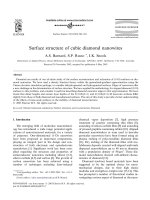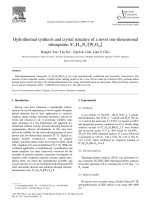Structure of lecture
Bạn đang xem bản rút gọn của tài liệu. Xem và tải ngay bản đầy đủ của tài liệu tại đây (3.09 MB, 83 trang )
RESISTIVITY
1
Resistivity - Truong Quoc Thanh
11/7/2016
Structure of lecture
1. Basic physics of electric current flow
2. Resistivity of rocks
3. Equation on resistivity surveying
4. Summary of resistivity methods: case histories
5. Conclusions
2
Resistivity - Truong Quoc Thanh
11/7/2016
1. Basic physics of electric current flow
Simple resistor in circuit
Ohm’s Law states that for a resistor, the resistance (in
ohms), R is defined as
V
Resistance R
I
V = voltage (volts); I = current flow (amps)
Electric current flow in a finite volume
Ohm’s Law as written above describes a resistor,
which has no dimensions. In considering the flow of electric
current in the Earth, we must consider the flow of electric
current in a finite volume. Consider a cylinder of length L
and cross section A that carries a current I
3
Resistivity - Truong Quoc Thanh
11/7/2016
1. Basic physics of electric current flow
Electric current flow in a finite volume
where ρ is the electrical resistivity of the material (ohm-
m). This is the resistance per unit volume and is an
inherent property of the material
4
Resistivity - Truong Quoc Thanh
11/7/2016
1. Basic physics of electric current flow
If we were to examine two cylinders made of the same
material, but with different dimensions, they would have
the same electrical resistivity, but different electrical
resistances.
Often it is more convenient to discuss the conductivity (σ)
which is measured in Siemens per metre.
= 1/
Resistivity is the physical property which determines
the aptitude of this material to be opposed to the
passage of the electrical current
5
Resistivity - Truong Quoc Thanh
11/7/2016
1. Basic physics of electric current flow
Electric current flow across a slab of material
Consider an electric current (I)
flowing through a slab of material
with resistivity, ρ and crosssectional area, A
Applying Ohms Law
V
R
I
=>
6
Resistivity - Truong Quoc Thanh
11/7/2016
1. Basic physics of electric current flow
Electronic conductibility
The current flows by displacement
of electrons. Known as electronic
conductibility or metallic because
it is a similar conductibility to that
of metals. This solid conductibility
is really significant only for certain
massive mineral deposits.
7
Resistivity - Truong Quoc Thanh
11/7/2016
2. Resistivity of rocks
Electronic conductibility
The current is carried by ions. The
electrical resistivity of rocks
bearing water is controlled mainly
by the water which they contain.
8
Resistivity - Truong Quoc Thanh
11/7/2016
2. Resistivity of rocks
Electronic conductibility
The resistivity of a rock will depend:
on the resistivity of the natural pore water and consequently
the quantity of dissolved salts in the electrolyte
1g/liter=1000 ppm
on the quantity of electrolyte contained in the unit of rock
volume (saturation)
on the mode of electrolyte distribution, porosity
9
Resistivity - Truong Quoc Thanh
11/7/2016
2. Resistivity of rocks
Effect of temperature
A rock totally frozen is infinitely resistant and it is
impossible to implement resistivity methods (use EM methods)
The resistivity in brines decreases as the total dissolved
solids (TDS) increases
ρ = 4.5 TDS-0.85 (ohm-m)
10
Resistivity - Truong Quoc Thanh
11/7/2016
11
Resistivity - Truong Quoc Thanh
11/7/2016
2. Resistivity of rocks
Archie´s Law
Pure materials are rarely found in the Earth and most rocks are a
mixture of two or more phases (solid, liquid or gas). Thus to
calculate the overall electrical resistivity of a rock, we must
consider the individual resistivity and then compute the overall
electrical resistivity. Consider a sandstone saturated with salt
water. The grains are quartzite and have a high resistivity (>
1000 ohm-m).
In contrast, the pore fluid is conductive (~1 ohm-m).
To compute the overall electrical resistivity, we must consider
current flow through each phase. However, given the much
higher resistivity of the grains, most current will flow through
the water, with ions as the charge carriers.
12
Resistivity - Truong Quoc Thanh
11/7/2016
2. Resistivity of rocks
Archie´s Law
ρ resistivity of the rock
ρw resistivity of the fluid (water)
Φ porosity
S saturation in water
a factor which depends of the lithology (varies between 0.6 and 2)
m cementation factor (depends of the pores shape, of the
compaction and varies between 1.3 for unconsolidated sands to 2.2
for cemented limestone
n about 2 for majority of the formations with normal porosities
containing water between 20 and 100 %.
13
Resistivity - Truong Quoc Thanh
11/7/2016
2. Resistivity of rocks
Formation factor F
= wa-mS-n
= wFS-n
For sand and sandstones: F ≈ 0.62/2.15
For well cemented rocks: F ≈ 1/2
14
Resistivity - Truong Quoc Thanh
11/7/2016
2. Resistivity of rocks
Physical interpretation of the cementation factor, m
15
Resistivity - Truong Quoc Thanh
Note that the elongated pores
will connect to form an
interconnected
electrical
network at a lower porosity
than the spherical pores. Is
the permeability of the two
cases different?
The above discussion shows
that the resistivity of a fluid
saturated rock depends on the
amount of fluid and it’s
distribution
(degree
of
interconnection).
11/7/2016
2. Resistivity of rocks
To emphasize this point, consider the two limiting
cases of the fluid distribution.
A – Fluid in cracks parallel to electric current flow
The sample has 10% porosity. This
fluid geometry represents a parallel
circuit, and electric current can
effectively bypass the resistive rock
grains and travel through the sample
entirely in the conductive liquid.
What is the overall resistivity of the cube?
16
Resistivity - Truong Quoc Thanh
11/7/2016
2. Resistivity of rocks
To emphasize this point, consider the two limiting
cases of the fluid distribution.
B – Fluid in cracks perpendicular to the electric current flow
The sample has 10% porosity. This
geometry represents a series circuit,
and electric current cannot effectively
bypass the resistive rock grains. It
must travel through both the
conductive liquid and resistive rock
grains.
What is the overall resistivity of the cube?
17
Resistivity - Truong Quoc Thanh
11/7/2016
2. Resistivity of rocks
Result of influence of fluid geometry on bulk resistivity
18
Resistivity - Truong Quoc Thanh
11/7/2016
2. Resistivity of rocks
Resistivity of rocks and minerals
Air, gas or oil: infinite or very high resistivity!
Liquid materials from landfills are generally conductive (<10 ohm.m)
19
Resistivity - Truong Quoc Thanh
11/7/2016
2. Resistivity of rocks
Effect of clay and graphite
Clay has a high ionic exchange capacity, therefore the conductivity of
the pore fluid largely increases
Archie´s Law is not valid if clay is present!
Graphite, often associated with pyrite, makes the resistivity decrease
If a rock contains clay minerals, then an extra conduction pathway is
possible via the electrical double layer that forms at the interface of the
clay mineral and the water. This effectively allows ions to move
through the system with a lower effective viscosity (higher mobility)
than in the liquid phase
20
Resistivity - Truong Quoc Thanh
11/7/2016
2. Resistivity of rocks
Effect of clay and graphite
Clay has two meanings. It can refer to
certain sheet silicate minerals, and also
to sediment that has particles smaller
than 1/256 mm.
These definitions are not independent
as weathering of clay minerals usually
forms small particles.
If a rock contains clay minerals, then
an extra conduction pathway is
possible via the electrical double layer
that forms at the interface of the clay
mineral and the water.
21
Resistivity - Truong Quoc Thanh
11/7/2016
2. Resistivity of rocks
Effect of clay and graphite
Waxman and Smits (1968) developed an equation for the
resistivity due to conduction through both the liquid and the double
layer
where B is the equivalent conductance of the ions in solution
and F is the formation factor and
with ρm the matrix grain density and CEC the cation exchange
capacity of the clay. Thus the term BQv is a measure of how much
the clay contributes to conduction.
Values of CEC vary from one type of clay to another. For
example: smectite, CEC = 120; illite, CEC = 20.
22
Resistivity - Truong Quoc Thanh
11/7/2016
2. Resistivity of rocks
Factors that will DECREASE the resistivity of a rock:
(a) Add more pore fluid
(b) Increase the salinity of the pore fluid - more ions to conduct electricity
(c) Fracture rock to create extra pathways for current flow
(d) Add clay minerals
(e) Keep fluid content constant, but improve interconnection between pores
Factors that will INCREASE the resistivity of a rock
(a) Remove pore fluid
(b) Lower salinity of pore fluid
(c) Compaction - less pathways for electric current flow
(d) Lithofication - block pores by deposition of minerals
(e) Keep fluid content constant, but decrease connection between pores
23
Resistivity - Truong Quoc Thanh
11/7/2016
2. Resistivity of rocks
The conductivity of a rock increases if…
The quantity of water increases
The salinity increases (quantity of ions)
The quantity of clay increases
The temperature increases
The low resistivity phase dominates the overall resistivity.
Overall resistivity is very sensitive to the geometry
(distribution of the fluid).
24
Resistivity - Truong Quoc Thanh
11/7/2016
2. Resistivity of rocks
Highest R Igneous Rocks
Why? Only a minor component of pore water
Metamorphic Rocks
Why? Hydrous minerals and fabrics
Sedimentary Rocks
Why? Abundant pore space and fluids
Lowest R
Clay: super low resistivity
25
Resistivity - Truong Quoc Thanh
11/7/2016









